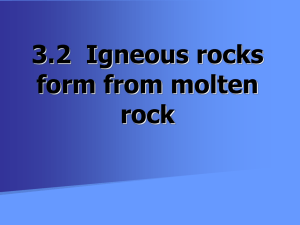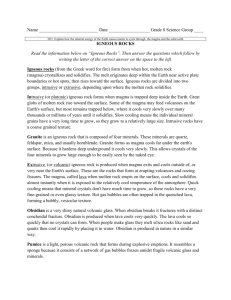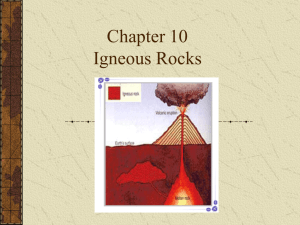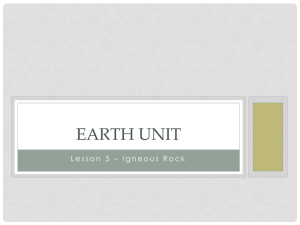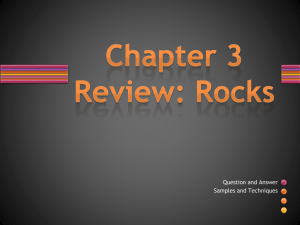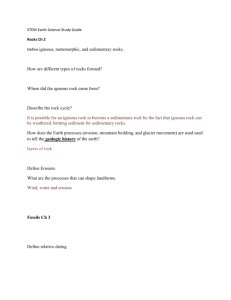Igneous rock notes key
advertisement
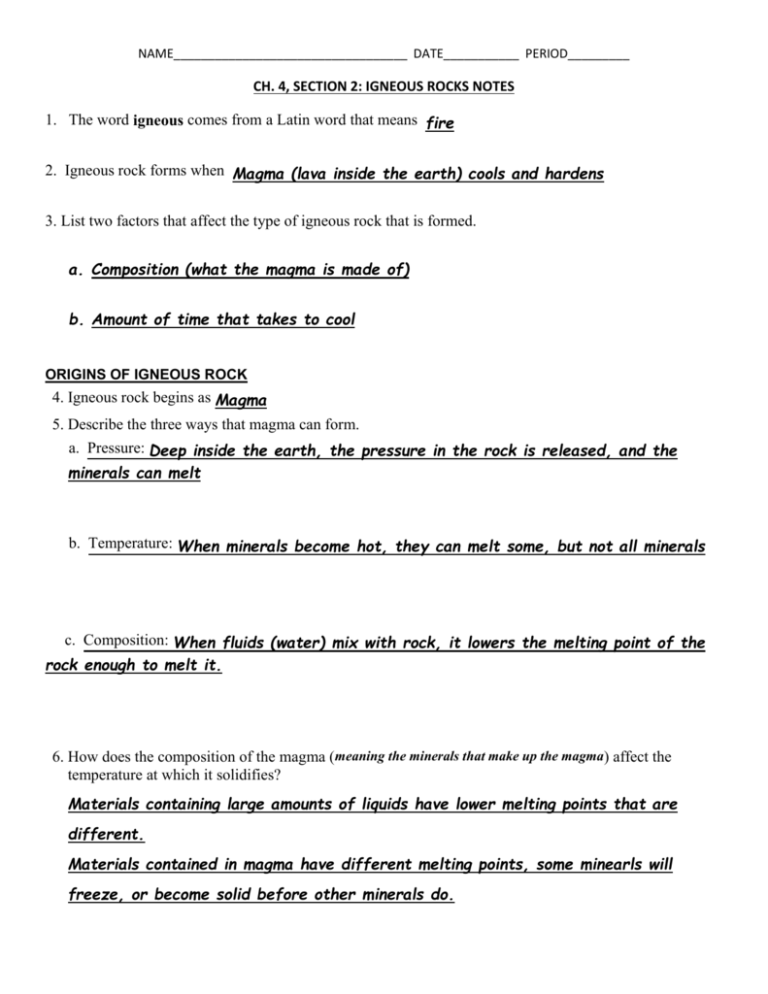
NAME__________________________________ DATE___________ PERIOD_________ CH. 4, SECTION 2: IGNEOUS ROCKS NOTES 1. The word igneous comes from a Latin word that means fire 2. Igneous rock forms when Magma (lava inside the earth) cools and hardens 3. List two factors that affect the type of igneous rock that is formed. a. Composition (what the magma is made of) b. Amount of time that takes to cool ORIGINS OF IGNEOUS ROCK 4. Igneous rock begins as Magma 5. Describe the three ways that magma can form. a. Pressure: Deep inside the earth, the pressure in the rock is released, and the minerals can melt b. Temperature: When minerals become hot, they can melt some, but not all minerals c. Composition: When fluids (water) mix with rock, it lowers the melting point of the rock enough to melt it. 6. How does the composition of the magma (meaning the minerals that make up the magma) affect the temperature at which it solidifies? Materials containing large amounts of liquids have lower melting points that are different. Materials contained in magma have different melting points, some minearls will freeze, or become solid before other minerals do. COMPOSITION AND TEXTURE OF IGNEOUS ROCK 7. Compare & contrast felsic and mafic igneous rocks. Include examples. Felsic Light Colors Both Rock Mafic Dark Colors More dense Less dense Felsic and Mafic are both types of rocks. They have different materials in their composition that makes them different densities and colors. Felistic rocks are composed of aluminum, potassium, silicon, and sodium. Felistic rocks are light in color, and less dense rocks like . Examples include granite and rhyolite. Mafic rocks are composed of dense, dark materials like calcium, iron, and magnesium. Examples of mafic rocks include gabbro and basalt. 8. The longer it takes for a rock to cool and solidify, the more time crystals have to grow, giving the rock a(n) course grain. 9. _The more quickly an igneous rock cools and solidifies, the finer the grain. IGNEOUS ROCK FORMATIONS TERM DESCRIPTION 10. pluton Name of intrusive igneous rock based on Large size and irregularshape of the intrusive body 11. batholiths Name of intrusive igneous rock based on its having the largest of intrusions Sheet-like intrusions that cut 12. dikes across previous rock units Sheet-like intrusions that are 13. sills oriented parallel to the previous rock units. 14. Magma intrudes or pushes, into surrounding rock below the Earth’s surface to create such formations as batholiths and sills. 15. Intrusive igneous rock usually has a(n) course grained texture 16 .Igneous rock that forms from lava, or magma that erupts onto the Earth’s surface, is called extrusive igneous rock 17. Lava can either erupt or flow from long cracks in the Earth’s crust called fissures 18. When lava flows from fissures on the ocean floor at places where tension is causing the ocean floor to be pulled apart, new ocean floor is formed. 19. When a large amount of lava flows out of fissures onto land, the lava can cover a large area and form a plain called a(n) lava plateau 20. Compare and contrast intrusive and extrusive igneous rocks. Give an example of each! Intrusive Extrusive Inside the crust, Both Earth’s surface, Batholiths, Stocks, Sills, Dikes, Magma / Lava Lava flow / eruption spreads, Course grain Rock Fine Grain 21. Write a paragraph summarizing what you have learned about igneous rocks!

